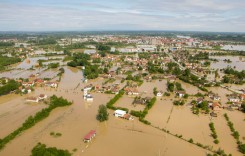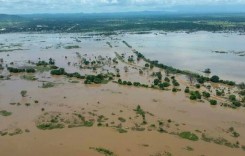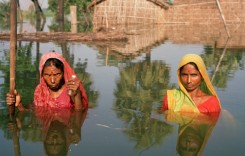Almost 700 people have now lost their lives as a result of weeks of monsoon rains in Pakistan, including 42 people who died in the last 2 days. Over 1.5 million people have now been affected, with thousands moving to relief camps for safety.

Pakistan has already received over 95 per cent of its total normal monsoon rainfall. The heavy rain continues to fall and Padidan in Sindh Province recorded 595 mm in 48 hours to 20 August 2022.
Since the start of the monsoon in mid-June this year, heavy rain has caused houses to collapse, flash floods, mudslides and landslides. Higher temperatures and heavy rain caused Glacial Lake Outburst Floods (GLOF) in mountainous areas of Balochistan and Khyber Pakhtunkhwa.
Rainfall has also increased river levels. Images provided by the United Nations Satellite Centre UNOSAT on 15 August revealed 1,550 km² of land was flooded in Balochistan and Sindh, with around 410,000 people potentially exposed to the floods close the Indus river and tributaries.
Pakistan’s National Disaster Management Authority (NDMA) said that, as of 19 August 2022, the Indus and Kabul rivers were above the flood mark in several locations. Flooding along the Indus has been particularly severe in Taunsa in Punjab Province over the last few days.

Over 1.5 Million Affected, 692 Fatalities
NDMA reported a total of 692 fatalities and 1146 injured across the country. By comparison, by mid-September 2021, NDMA reported a total of 187 people had died as a result of monsoon rain and floods.
The highest number of the fatalities has occurred in Balochistan, where 207 people have died and 81 injured since the start of the monsoon in mid-June this year. Khyber Pakhtunkhwa Province has recorded 138 deaths, Punjab 144 and Sindh 159.
Many of the fatalities were a result of poorly constructed homes collapsing during heavy rain and storms. Over 20,000 homes have been destroyed and nearly 90,000 damaged, according to the latest NDMA report.
Over 1.5 million people across the country have been affected by the monsoon rain, including 1,053,812 in Sindh Province; 360,000 in Balochistan; 119,367 in Punjab; 50,000 in Khyber Pakhtunkhwa; 7,360 Gilgit-Baltistan; and 2,000 in Azad Jammu and Kashmir. Authorities and emergency teams have rescued over 10,000 people. As of 20 August, NDMA reported around 20,000 people were staying in relief camps. Over 70,000 tents have been distributed by provincial and national disaster agencies, along with blankets, mosquito nets, water, food, hygiene and other relief items.
Health Risks and Food Insecurity
Dozens of health facilities have also suffered damage, reducing access to health care for many of those in affected areas at a time it is most required.
In a recent report, the UN Office for the Coordination of Humanitarian Affairs (OCHA) said “compounding the inhibited access to healthcare, demand for health services is expected to rise due to increased cases such as of Acute Watery Diarrhoea (AWD), respiratory tract infections (RTI), Malaria, skin infections, snake bites and injuries. The largest national nutrition survey conducted in Pakistan, the 2018 National Nutrition Survey (NNS 2018), found that more than 55 per cent of the population does not follow safe hygiene practices, and practices such as open defecation – already practiced by some 30 per cent of people prior to the ongoing floods, according to a Multiple Indicator Cluster Survey (MICS) – are expected to increase. Additionally, preliminary estimates suggest that some 20 per cent of the drinking supply systems in Balochistan were damaged in the floods, reducing access to safe and clean water.”
Livelihoods have been decimated in rural areas. Over 500,000 livestock have perished as a result of the floods in particular in Balochistan. Furthermore, the Pakistan Food Security and Agriculture Working Group (FSAWG) estimates that more than 1,000 animal shelters have been damaged, and that over 1 million acres of crops have been affected by the recent floods, increasing the risk of food insecurity.
The Government of Pakistan has identified Food Security, Agriculture and Livestock; Health; Water, Sanitation and Hygiene (WASH); and Shelter and Non-Food Items (NFI) as priority needs for the immediate flood response.
On 05 August, Prime Minister Shehbaz Sharif announced the release of PKR 5 billion (US$22.7 million) to support the flood victims, as well as the creation of a relief fund for flood-affected people to which the public can donate.










